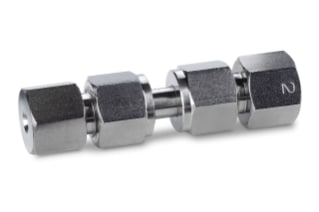
Waters Ultrahydrogel Columns contain a sophisticated aqueous-compatible gel column for analytical and preparative separations of water-soluble polymers. The gel is a cross-linked hydroxylated polymer and contains some residual carboxyl functionality. Ultrahydrogel DP contains some residual amine functionality. Compounds normally characterized include oligomers and biological substances such as polysaccharides, nucleic acids, proteins, and peptides.
|
Chemistry |
SEC |
|
Separation Mode |
Gel Filtration (aqueous) |
|
Particle Substrate |
Polymer |
|
pH Range Min |
2 pH |
|
pH Range Max |
12 pH |
|
Temperature Limits |
10 - 80C |
|
Molecular Weight Range Min |
1000 |
|
Molecular Weight Range Max |
500000 |
|
Particle Shape |
Spherical |
|
Particle Size |
6 µm |
|
Endfitting Type |
Waters |
|
Pore Size |
125 Å |
|
Format |
Guard Column |
|
Packing Solvent |
Water |
|
System |
HPLC |
|
Technique |
SEC |
|
USP Classification |
L25 |
|
Inner Diameter |
6 mm |
|
Length |
40 mm |
|
UNSPSC |
41115709 |
|
Application |
Gel Filtration |
|
Brand |
Ultrahydrogel |
|
Product Type |
Guards |
|
Units per Package |
1 pk |
Ultrahydrogel Guard Column, 125Å, 6 µm, 6 mm X 40 mm, 1K - 500K, 1/pk
Use the Ultrahydrogel Guard Column to enhance the lifetime of the analytical column. The guard column is made using the identical high-performance packing materials as the Ultrahydrogel analytical column, which makes it ideally suited to be used with it. The guard is a type of protective lab equipment that is installed between the injector and the analytical column. It works by removing the chemical impurities and suspended solids from reaching the analytical column.
The Ultrahydrogel column is a sophisticated aqueous-compatible gel lab equipment for analytical and preparative separations of water-soluble polymers. Compounds normally characterized include oligomers and biological substances such as polysaccharides, nucleic acids, proteins, and peptides. To ensure that this sophisticated and crucial column lasts a long time, it is imperative that it be paired with the Ultrahydrogel Guard Column, which is designed to protect it while giving accurate analysis results. This also results in lowered lab equipment costs as you do not need to replace the analytical column frequently.
Like all Waters equipment, the Ultrahydrogel Guard Column is also manufactured in a cGMP, ISO 9001 certified plant using ultra-pure reagents. In addition to this, each batch of the Ultrahydrogel Guard Column packing material is tested chromatographically to ensure the highest quality. The results are held to the highest standards and the narrowest specification ranges to assure excellent, reproducible performance every single time.
To get information regarding contacting our various offices and to shop for lab equipment, be sure to further explore our website. While we have included all information regarding our products, including specifications, technology, research, and related products on the website, you can reach our members of staff with any questions you may have.
You may also be interested in Reversed-Phase QC Reference Material which is a specially formulated mix used to confirm the benchmark performance of your analytical HPLC or UPLC system. Included in the mix are the following 7 compounds: uracil, butylparaben, naphthalene, propranolol, dipropyl phthalate, acenaphthene, and amitriptyline at pH 7.
How Will I Know When The Ultrahydrogel Guard Column Needs To Be Replaced?
The guard column has a finite capacity for impurities. You will know from the number of sample injections or an observed change in backpressure when a change of guard column is required. If the capacity of the guard column is exceeded, undesirable contaminants will elute onto the analytical column.